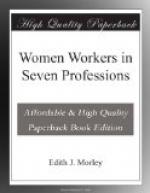With regard to this employment of women after marriage, there would seem to be no reason why the principals or assistants of colleges or institutes, or the women with private practices should not continue their work; but in schools, even where the terms of the appointment do not demand resignation on marriage, it is not customary for married teachers to be employed.
Up to the present, the supply of trained gymnastic teachers has scarcely satisfied the demand, and fresh openings are from time to time created. When physical exercises were made compulsory in all the elementary schools, the class teacher had and still has, to give this instruction to her class, but there has been an increasing demand for organisers to teach the elementary school teacher and superintend her work. This has also led to specialist teachers being appointed to all the elementary training colleges and pupil teachers’ centres. Then came medical inspection, and with it the need for school clinics, which could not be complete without a department for treating curvatures, flat feet, etc., and giving breathing exercises, especially after the removal of adenoids. Though these clinics are only in the experimental stage they are sure to expand, and it is expected that a large number of trained gymnastic teachers will be required for them. Further it is possible, and may be found desirable, that specialist teachers should be appointed for groups of elementary schools, so relieving the class teachers of this part of their work. Large secondary and private schools often appoint two, three, or four trained teachers who are jointly responsible for gymnastics, games, dancing, swimming, and the treatment of deformities throughout the school. Besides all these openings a considerable number of gymnastic teachers find work in the colonies, especially in South Africa, Australia, and New Zealand.
To band together the teachers of Swedish gymnastics and to guard their interests generally, the Ling Association was founded in 1899. Though it is open to men and women, very few men have joined, as the number of men with the necessary qualifications is very small. Members must have trained for at least two years at a recognised college, and it was not till 1912 that the first training college for men was opened in England.




